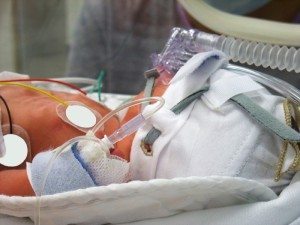Hypoxic Ischemic Encephalopathy (HIE) Attorneys in Detroit, Michigan
Because the damages resulting from HIE are so severe, medical professionals are obligated to thoroughly diagnose, control, treat, and avoid any possible risk factor or cause for birth asphyxia. At Michigan Cerebral Palsy Attorneys, our team consists of hypoxic ischemic encephalopathy lawyers, a registered obstetrical nurse, infant respiration experts, HIE professionals, and others familiar with the fields of law and medicine. Our HIE and birth trauma team has specifically handled cases related to hypoxic ischemic encephalopathy for decades, making Michigan Cerebral Palsy Attorneys one of the only birth trauma and HIE-focused law firms in the country. We thoroughly understand the process of pursuing hypoxic ischemic encephalopathy birth trauma cases in Michigan and are committed to providing support at every step of the litigation process.
If you know a child whose birth resulted in hypoxic ischemic encephalopathy, our Detroit, Michigan hypoxic ischemic encephalopathy (HIE) lawyers are here to help you understand your legal options and pursue a birth trauma case. Michigan Cerebral Palsy Attorneys encourages you to reach out for HIE help today—you may contact us by completing our online contact form or calling toll-free at (888) 592-1857. The Detroit, Michigan Hypoxic Ischemic Encephalopathy (HIE) Lawyers at our birth injury law firm look forward to speaking with you.
What Causes HIE?
 Hypoxic ischemic encephalopathy (HIE) is the result of infant oxygen deprivation—since brain cells require oxygen to function, any interference to oxygen flow to the brain may result in cell death and brain damage. The longer and more severe the oxygen-depriving insult, the more extreme the baby’s brain damage will be. Oxygen deprivation takes two possible forms in cases of HIE:
Hypoxic ischemic encephalopathy (HIE) is the result of infant oxygen deprivation—since brain cells require oxygen to function, any interference to oxygen flow to the brain may result in cell death and brain damage. The longer and more severe the oxygen-depriving insult, the more extreme the baby’s brain damage will be. Oxygen deprivation takes two possible forms in cases of HIE:
- Ischemia: Decreased blood flow to the baby’s brain is known as ischemia.
- Hypoxia: Decreased oxygen in the baby’s blood is known as hypoxia (or hypoxemia).
Several complications occurring before, during, or after labor and delivery may limit oxygen flow and result in hypoxic ischemic encephalopathy. As you’ll see in this section, it is crucial for medical professionals to properly address, control, treat, and prevent the following situations in order to protect babies from hypoxic ischemic events:
- Delayed C-Section: Failing to quickly order and perform emergency Cesarean section deliveries in cases of fetal distress is a cause of HIE. Fetal distress signals indicate infant oxygen deprivation, so emergency C-section deliveries must happen quickly in order to avoid cutting off a baby’s oxygen supply.
- Fetal monitoring errors also may lead to hypoxic ischemic encephalopathy. When a medical professional fails to properly read fetal heart tracings, he or she runs the risk of missing important indicators that the baby is experiencing oxygen deprivation. Failure to accurately read fetal heart monitors often leads to the failure to perform emergency C-section deliveries.
- Uterine Rupture: Uterine rupture is a labor and delivery emergency that occurs when the uterus tears. Uterine rupture can cause HIE because a) maternal blood loss from the injury results in decreased blood flow to the placenta and baby and b) the uterine rupture may occur where the placenta is attached to the uterus, consequently separating the placenta from the mother’s blood and oxygen supplies.
- Vaginal Birth after Cesarean (VBAC) deliveries increase a mother’s risk for uterine rupture, thus increasing the baby’s chance for experiencing HIE.
- Placental Abruption: Placental abruption occurs when the uterus and placenta separate. This can limit oxygen flow to the baby and result in a hypoxic ischemic event.
- Irregular Neonatal Presentation and Size: The following abnormalities in size and fetal presentation can cause hypoxic ischemic encephalopathy:
- Macrosomia: Macrosomic babies are larger than average for their gestational ages and risk cord problems, failure to pass through the mother’s pelvis, and other complications limiting oxygen flow.
- Cephalopelvic Disproportion (CPD): CPD occurs when a baby is too large to fit through his or her mother’s pelvis. CPD often results in labor that fails to progress, head trauma, and birth asphyxia.
- Malpresentation: Breech presentation, face presentation, or other irregular fetal presentations make labor difficult, compromise umbilical cord function, and may result in HIE.
- Placental Previa: Placental previa occurs when the placenta partially or fully covers the opening of the uterus, blocking the birth canal.
- Umbilical Cord Complications: Since the umbilical cord is the baby’s lifeline to blood, oxygen, and nutrients, any interruption to the functioning of the umbilical cord interferes with oxygen supply.
- Umbilical Cord Prolapse and Compression: Cord prolapse refers to a complication in which the umbilical cord enters the birth canal before the baby, often becoming compressed and limiting oxygen supply to the baby.
- Short Umbilical Cord: Short cords limit fetal movement within the womb, ultimately causing growth restrictions.
- Nuchal Cords: Nuchal cords and true knots cause HIE because they interrupt the flow of oxygen through the cord.
- Maternal Infections, complications, and conditions such as preeclampsia, chorioamnionitis, premature rupture of membranes (PROM), polyhydramnios, oligohydramnios, bacterial vaginosis (BV), Group B Strep (GBS), and many others may, when left improperly addressed, interfere with the flow of oxygenated blood to the baby’s brain.
- Post Term Pregnancies: Beyond 37 gestational weeks, the placenta and uterus deteriorate and provide less oxygenated blood to the baby. This limited passage of oxygenated blood may lead to a hypoxic ischemic event.
- Intracranial Hemorrhages (Brain Bleeds): Intracranial hemorrhages result from traumatic forces on a neonate’s head (for instance, the misuse of vacuum extractors or forceps) and may result in hypoxic ischemic encephalopathy.
Which Medical Errors Cause Hypoxic Ischemic Encephalopathy?
Detroit, Michigan Hypoxic Ischemic Encephalopathy (HIE) Lawyers Discuss HIE & Medical Malpractice
Medical professionals are obligated to have a thorough understanding of the causes and risk factors for hypoxic ischemic encephalopathy. Any error made by a medical professional that results in HIE or another injury to the mother and/or baby is medical malpractice. For reference, below we’ve listed a few examples of medical malpractice in cases of hypoxic ischemic encephalopathy. If you identify one of the following situations (or another like it) from your experience, you may have grounds for a birth trauma case.
- Failure to properly manage ventilation equipment and infant respiration after a baby is born
- Failure to adequately manage anemia (low red blood cell count) after a baby is delivered
- Failure to properly identify, address and act on fetal distress signals
- Failure to provide hypothermia treatment for an infant that suffered a hypoxic ischemic event; failure to perform hypothermia treatment under the correct standards and indications
- Failure to diagnose, treat, control and/or prevent any possible causes or risk factors for hypoxic ischemic encephalopathy
Treatment for Hypoxic Ischemic Encephalopathy (HIE)
 Hypoxic ischemic encephalopathy results in lifelong brain damage, so most treatment options are geared towards supporting, adjusting to, and improving impairments and damages. For instance, many individuals with lasting impairments from HIE participate in therapy programs, use adaptive equipment and assistive technologies, and have specialized lifestyle supports.
Hypoxic ischemic encephalopathy results in lifelong brain damage, so most treatment options are geared towards supporting, adjusting to, and improving impairments and damages. For instance, many individuals with lasting impairments from HIE participate in therapy programs, use adaptive equipment and assistive technologies, and have specialized lifestyle supports.
However, a procedure known as Hypothermia Treatment (or brain cooling) has been introduced to patients specifically for hypoxic ischemic encephalopathy. To complete the treatment, medical professionals bring the baby’s body temperature down to about 91 degrees Fahrenheit for 72 hours. The treatment allows brain cells to recover, ultimately avoiding further damage from the hypoxic ischemic insult. Learn more about hypothermia treatment here.
Hypoxic Ischemic Encephalopathy (HIE) Resources in Detroit, Michigan
Hypoxic ischemic encephalopathy often results in cerebral palsy, mobility limitations, seizure disorders, intellectual impairments, and other lifelong disabilities. At Michigan Cerebral Palsy Attorneys, we understand how overwhelming and time-consuming the search for lifestyle and medical supports can be. We’ve compiled an exhaustive list of disability and HIE resources in Detroit, Michigan (and other Michigan cities) containing information related to health care, financial aid, insurance, special education, adaptive equipment, treatment, therapy, and much more. Visit our Detroit Cerebral Palsy resources page here.
Legal Help for Detroit HIE Victims
Detroit, Michigan Hypoxic Ischemic Encephalopathy (HIE) Lawyers & Attorneys
 The Detroit HIE lawyers at Michigan Cerebral Palsy Attorneys have decades of precise experience providing legal help to the children and families affected by hypoxic ischemic encephalopathy, cerebral palsy, and other traumatic birth injuries. Call our Detroit, Michigan hypoxic ischemic encephalopathy (HIE) lawyers today toll-free at (888) 592-1857 or contact us online here.
The Detroit HIE lawyers at Michigan Cerebral Palsy Attorneys have decades of precise experience providing legal help to the children and families affected by hypoxic ischemic encephalopathy, cerebral palsy, and other traumatic birth injuries. Call our Detroit, Michigan hypoxic ischemic encephalopathy (HIE) lawyers today toll-free at (888) 592-1857 or contact us online here.
To learn more about hypoxic ischemic encephalopathy, we encourage you to visit the following resources:
- Hypoxic Ischemic Encephalopathy: Cerebral Palsy from HIE: Learn all about hypoxic ischemic encephalopathy through this page: HIE facts, causes, risk factors, associated injuries, treatment and therapy options, signs and symptoms, diagnosis, and legal options.
- Detroit, Michigan Disability and Cerebral Palsy Resources: A comprehensive list of HIE and disability resources specific to Detroit, Michigan–hospitals, health care resources, care, financial aid, insurance, special education, housing, transportation, employment, adaptive equipment and assistive technology, accessible playgrounds, foundations and charities, disability organizations, research, information, support groups, parent and family resources, treatment, therapy, surgery, and more.
- Hypoxic Ischemic Encephalopathy Infographic: A description of HIE for visual learners.
- Hypoxic Ischemic Encephalopathy Linked to ADHD in Children: Learn more about this associated disorder.
- The Relationship between Hypoxic Ischemic Encephalopathy (HIE) and Cerebral Palsy: More information about how hypoxic ischemic encephalopathy causes cerebral palsy.
- Hypothermia Treatment for Hypoxic Ischemic Encephalopathy: Learn about hypothermia treatment and how it reduces the neurological damage caused by hypoxic ischemic encephalopathy. Read more about the science behind hypothermia treatment, eligibility for the treatment, and more.
- Choosing a Michigan HIE Lawyer for Your HIE Case
